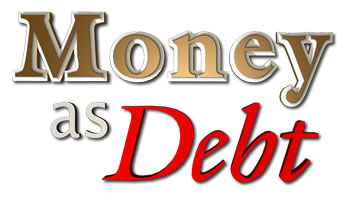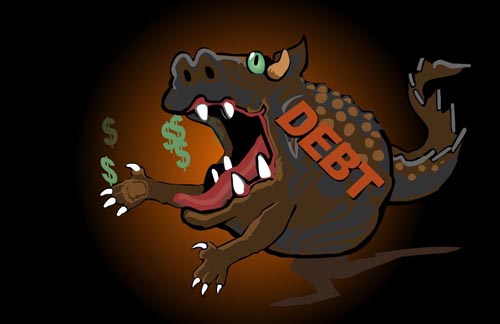
Mortgages
Most money today is created by the issuing of mortgages. Builders borrow at interest from banks to build houses and hope to sell all their houses before the interest rate eats up their profits. Then the buyers borrow at interest from banks to pay the builders who pay back their banks. A 30-year mortgage at interest will not only mean the ultimate price of a house will be much higher, it means the bank gets most of the money. It also creates money in the system now, that won't be fully justified by the borrowers' productivity for 30 years!
Mortgages Chapter from Money as Debt III
Producer Credits would provide opportunities to do things
unimaginable in the current system.
In the Producer Credit system, builders could issue their own Credits to pay their expenses. Such builders would not be carrying any debt to banks. Their only legal obligation would be to provide the products they promised, on time. And they could capitalize new construction anytime by issuing new Producer Credits.
The builder has both the ability and the responsibility to create enough purchasing power to absorb all of its product. There would be no bankers to beg credit from, no payments to make and no “interest clock” to beat. That is because the builder’s only creditors would be their customers who have acquired the builder’s Credits in order to buy the buildings. All that is owed by the builder is product ready on time and this could include a lot of flexibility because, if needed, Credits could be rolled over to be redeemed later. The model of ownership is also radically changed.
The Partnership Model
Mortgages would take the form of partnerships, much as in pure Islamic banking. Initially the builder would form a partnership with the first buyer. There would be no need of a down payment. The buyer simply undertakes to buy out the builder’s ownership interest over time and, as long as the buyer is making payments and otherwise acting according to the agreement, the builder has only “silent partner” status.
Should the buyer fail to make the agreed upon payments, or otherwise violate the agreement, the builder would be entitled to “active partner” status, and could legally force the first buyer to sell their equity in the property, either to the builder to re-sell or directly to another party.
In the case of a secondary sale, the second buyer would not have the option of going to a bank and just creating new money to buy out the first buyer. This ability to create almost unlimited amounts of credit is what fuels asset speculation, flipping, debt bubbles and inflation. Instead, the second buyer would enter into the partnership agreement to buy out both the builder and the first buyer (now silent partners) over time.
Builders would issue Producer Credits in exactly sufficient quantity to absorb their entire product, and, not being in debt to banks, would have the freedom to adjust payments and payment periods with the agreement of the other parties. Under all circumstances, buyers would either retain ownership or be allowed to sell the equity share they had paid for. Eviction would still be possible for non-performance, but loss of equity would not.
Counter-cyclical by Design
The system is self-balancing. Long-term debt like mortgages stabilizes rather than capsizes the mathematics of the system. For example, in a building boom, an Issuer’s outflow of Producer Credits could be increased. It would be spent to build more homes. This increase in the outflow would have to be balanced by the increased inflow of payments from new sales and therefore, the builder's spending of its Producer Credits could only increase gradually in response to income received. Outside investment and/or the creation of more Producers would be required to meet a sudden strong demand.
In a housing slowdown, the builder’s outflow of Producer Credits would be reduced as fewer homes would need to be built. If this is due to a major economic downturn, customers may experience difficulty maintaining payments. The builder may have to lay off much of his workforce. However, the Issuer/builder is NOT in debt for "money" to a bank. His only legal obligation is to provide product in exchange for his own Producer Credits. And because slowdowns usually result in excess inventory, the builder probably has lots of product with which to honor his Producer Credits. That is not where his problem lies.
The problem is the inflow! The builder needs to balance incoming Credits with outgoing Credits to keep its Credits at par in the automated market. And outgoing Credits have been reduced. Therefore to keep the pace of inflow equal to the pace of outflow, the builder could do any or all of the following:
1. reduce its customers’ payments;
2. support its laid off workers;
3. create new credit and invest in new business opportunities creating new employment;
4. pay for a non-commercial activity like environmental clean up;
5. give money to charity;
6. spend lavishly on the boss and his friends.
Whichever course is chosen, no Issuer–builder would have to go bankrupt, and no home buyer need lose his or her home due to some inescapable math imposed by a bank on the issuance of your own credit.
Construction workers would still see their work reduced, but otherwise, this would be a very different scenario than today’s.
Today, mortgage payment Principal is extinguished when paid back to the originating bank. If not replaced by new money-as-debt, the money supply shrinks, causing mathematically inevitable defaults. People lose their homes through no fault of their own. This is the scarcity model at its worst.
In the proposed system, the builder must spend the abundance of mortgage payments that result from his creation of an abundance of homes back into the economy one way or another. Hardship is easily avoided.
Today a real estate slump leads to people camping outside empty vandalized houses, and insolvency of the banking system. This requires bailouts causing drastic increases in public debt and more recently, the theft of client deposits. ALL of this distress was created by our imprisonment in the scarcity model.
The scarcity model of money requires constant growth of debt to banks to avoid mathematically inevitable defaults.
The abundance model is self-balancing in both expansion and contraction.
back ~ 11 Advantages

